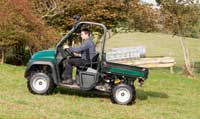Buggy Test: JCB Groundhog 4×4

JCB GROUNDHOG 4×4 – best load-independent suspension
First impressions:
The most modern-looking, in a moon-buggy sort of way. A bit too much plastic, but components are well made and common to other JCB machines. Our road-ready version looked a little unfinished, with some exposed wiring.
Chassis and suspension
Suspension is clearly an area that JCB took a lot of time over. Up front it’s pretty standard stuff with MacPherson-style coils and dampers. But at the back it has opted for independent trailing arms hinged just behind the seat and supported by variable-rate springs.
Engine and transmission
Power comes from a 768cc, 26hp Lombardini three-cylinder engine via belt-driven CVT. Positioned right in the centre of the chassis, this is good for weight distribution but means the Groundhog is decidedly loud.
Driveability
Though heavier to steer than the others, the JCB is manoeuvrable and responsive at low speeds. However it has a tendency to wander at higher speeds and can be tricky to get into 4wd and reverse.
The belt has a strong tendency to slip on steep hills. When ascending with a heavy load, it’s a case of pausing and waiting until the belt regains traction again.
Watch the test
Braking
Disc-brakes all round pull the Groundhog up particularly quickly when required. There’s very little engine-braking, so nifty simultaneous footwork on the brake and throttle is called for.
Practicality and servicing
Although ground clearance is not that high, a complete belly-guard means there’s nothing to get caught up on. The load bay helpfully opens on three sides but the Ifor Williams-style catches are fiddly.
Diesel and engine oil filters are grouped remotely away from the engine under the driver’s seat. A great idea but the road-legal version needs a washer bottle and that’s stuck in there too, making it too cramped to get to the filters.
Cab
An annoying safety beep sounds when you turn the key. There’s no speedo or fuel gauge but switches are neatly laid out and easy to get to. Comfortable, adjustable bucket seats and easy-to-pressure-wash flat floor are plus points.
Pros Protective/guard plate very good. Independent trailing arm suspension with variable load coils – loads of travel plus traction Tipping bay opens on all sides Disadvantages: Belt slippage – we weren’t able to find out whether the engine was capable or not Noisy common-rail engine Exposed electrics |
|---|
To see results from the other buggies click on the link below:
Kawasaki Mule 4010 Trans 4×4 – best all-rounder
Massey Ferguson 20 MD – best handling at speed
Kubota RTV 900 – best at braking
And for more pictures from the tests click here.

